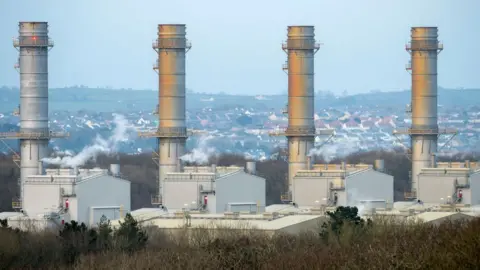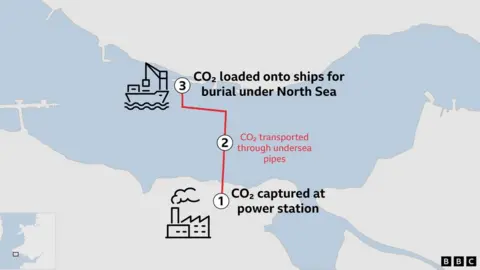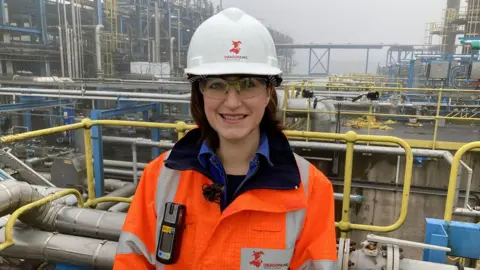Climate change: Plan to capture, ship and bury power station's CO2
 Getty Images
Getty ImagesPlans to lay new undersea pipes to carry carbon emissions from one of Europe's largest gas power stations have been unveiled.
The scheme would link Pembroke power station with a liquified natural gas (LNG) terminal across the Milford Haven estuary in Pembrokeshire.
Supporters said it would secure jobs and launch a new industry shipping CO2 from Wales to be buried at sea.
But it involves major building work across a protected marine habitat.
Environmental group Friends of the Earth called for the money to be spent on renewable energy rather than keeping a gas plant going.
Pembroke power station has the capacity to generate enough electricity from burning gas to power four million homes.
Despite being one of Wales' biggest emitters of CO2 it has an "essential role" in the country's transition to a greener future, according to its operator RWE.
"This power station currently runs 80% of the time, in and around when there's insufficient renewable power [such as wind or solar]," said Richard Little, who is leading the site's transformation as director of the Pembroke Net Zero Centre.
"We need to build something that allows it to still operate at times when it's needed without impacting the climate," he said.
RWE's answer, alongside new hydrogen production facilities which could eventually replace gas, is carbon capture and storage.
The firm's ambition is to capture up to 2 mega tonnes (Mt) of emissions by 2030, rising to 5Mt by 2035 - the equivalent of taking a million petrol cars off the road.
But this relies on establishing a way for that CO2 to be transported all the way to old, empty oil and gas fields in the North Sea where it can be buried.
That is where the new pipelines come in.

Just over half a mile away - across the Milford Haven waterway - is Dragon LNG - one of three terminals in the UK where natural gas in cold, liquid form arrives on giant tankers from overseas.
It is then warmed up, turned back into gas and sent on to homes and businesses.
Mirroring that process, the plan is for Pembroke power station's carbon emissions to be pumped across the estuary to be liquified and put onto ships at the LNG terminal.
Dubbed the Must project - which stands for Multi-Utility Service Transit - the pipelines would also carry waste heat from the power plant to help cut emissions involved in the LNG terminal's operations.
Hydrogen could also be transported in future - connecting businesses north of the haven with a supply of the cleaner fuel.
The aim is for the scheme to have been built before the end of the decade, with engineering studies under way, part funded by the UK government.
Getting approval from regulators to dig a trench and lay pipes across a busy shipping route and marine special area of conservation will be no mean feat.
"We're working closely with regulatory and environmental bodies to try and do this the right way - to go in once and do it well," Simon Ames, Dragon LNG's managing director said.
"We want to fully protect the [local] environment but dealing with climate change means we have to connect these businesses together."
RWE said it expected to be employing about 2,000 new workers by the end of the decade on construction work related to decarbonising Pembroke power station.
"As well as an environmental responsibility there's a socio-economic responsibility to grow these green jobs and skills in the south Wales area," said Eleri Morgan, a process engineer working on the power station's green hydrogen plans.

At Dragon LNG, Sarah Phillips was officially "employee number one" at the site when it started back in 2005 and has since risen to become a senior manager.
"Helping to secure that future for the local community, trying to increase the number of jobs and protect those we already have is something I really look forward to," she said.
Should the scheme prove successful, the hope is to replicate it at other industrial hotspots across south Wales - such as Port Talbot, Cardiff and Newport - establishing a CO2 shipping route, which the companies say will save tens of thousands of jobs by allowing established industries to decarbonise.
The project is part of the wider South Wales Industrial Cluster (SWIC) plan.
This involves major industries - responsible for about 40% of Wales' total greenhouse gas emissions - working together to map out how they cut carbon en masse.
"Rather than decarbonise through loss of industry, you invest hard," Mr Little said.
"That way you more than preserve the jobs and add more value to the economy."
But Friends of the Earth said there were reasons to be "incredibly sceptical" over the proposals.
Using carbon-capture technology on a gas power station would "tie us into fossil fuels for many decades to come", said Mike Childs, the group's head of science, policy and research.
Not all CO2 would be captured, while gas extraction itself leads to leakages of methane - another powerful greenhouse gas, he added.
"Rather than using gas to create electricity we need to move away from that entirely and focus on renewable energy and types of energy storage," he said.
Natural Resources Wales said it would support the project's feasibility study.
"Our priority will be finding solutions that enable decarbonisation ambitions while ensuring the sensitivity of the Pembrokeshire Marine special area of conservation and Milford Haven Waterway site of special scientific interest is fully understood and safeguarded as the proposals take shape," said its executive director Sarah Jennings.

- TOURIST TRAP: Meet the team selling Wales to the world
- FOR THE LOVE OF SPORT: The biggest names in Welsh sport and the stories behind them

